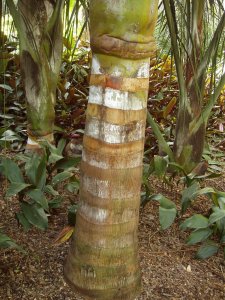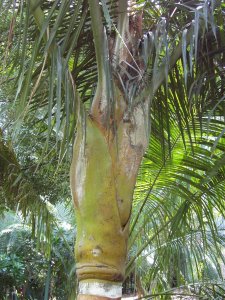Re: Dypsis prestoniana
Hi All,
Let me try and list what I believe are the distinguishing differences
between D. robusta and D. prestoniana. As seedlings the differences
have already been pointed out. D. robusta leaflets are regular and on
the same plane. D. prestoniana's forms leaflets are irregular grouped,
and can be plumose. See pics in above posts.
As they mature, they both develop colourful tomentum. D. robusta's
tomentum is more extensive, and more of a dark maroon colour, where as
the D. prestoniana's colour tends more toward an orange colour.
The D.robusta tomentum normally covers the whole crownshaft. And with "most"
of the D. prestoniana forms, the tomentum is held just above where the
petiole meets the crownshaft. This coloration becomes most intense just
as the palms begins forming a mature crownshaft, as they start trunking.
As both these palms approach maturity they tend to loose this colourful
tomentum. There appears to be a form that Gary Levine saw of a
possible D. prestoniana which retains it's tomentum. And there may be
others that retain a hint as well. But the D. robusta can lose 70% of
what it had when it was first forming a crownshaft..
This is truly when Dypsis robusta looks it's best.!!
(Just as it's holding all it's deep maroon tomentum and forming a trunk)
Also, it’s
VERY IMPORTANT to note that growing conditions can play a major
role in the appearance of some of these species. If one was to be grown
in a protected semi shaded area it, would retain more of it's colour for
much longer than one growing in an open area.
When grown in a fully exposed location it appears as if these palms will
lose much more of their colour and take on a whiter
appearance.
Below is a link to some great Hi-Def pics of Gary's possible D. prestoniana. Although I have never seen this form/species before, it
has a different colour tomentum to that of D. robusta!
The reason it has retained so much tomentum "could" be due to the
amount of light or lack of direct full sun exposure these palms are
in..?
GARY'S POSSIBLE D. PRESTONIANA
All of these Dypsis prestoniana forms have slightly different habits
in the way they evolve,or in the way they mature --- constantly changing,
even when near mature they change once again.!!
Once mature they all look very similar to each other...
The question then becomes how distant is D. robusta from this Dypsis
prestoniana complex..? I think John Dransfield is asking the same
question, as when he was at Jeff's place he took plant material to do
DNA sampling.
Clayton.

















